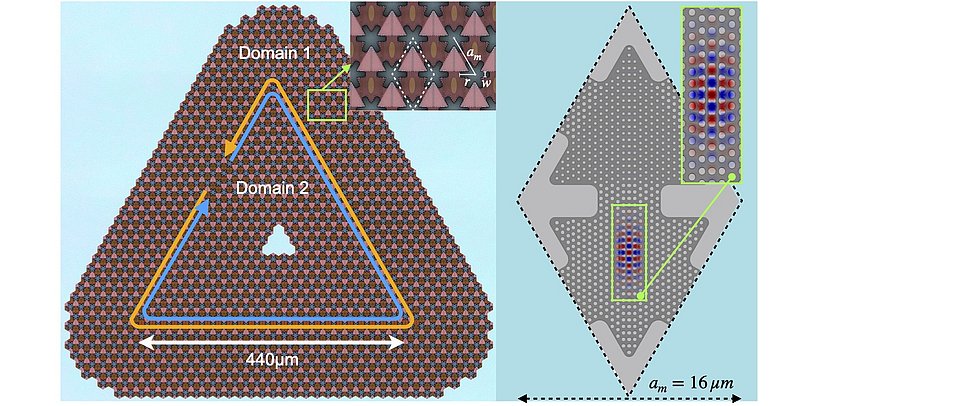Cavity Optomechanics meet Topological Phononics
In a theory-experiment collaboration between MPL and Caltech, the first demonstration of topological transport of mechanical vibrations in an optomechanical array was achieved. This unlocks the full toolbox of cavity optomechanics, such as cooling, mechanical lasing, sensitive readout, and optical control of mechanical modes, for the area of topological phononics.

In recent years, the field of nanomechanics has made its mark not only in fundamental physics, but also in applications such as sensing, signal processing, and emerging quantum technologies. Nanomechanics deals with the study of mechanical properties of physical systems at the nanometer scale. One of the most prominent applications of nanomechanics is the transport of information, encoded as mechanical vibrations. In this setting, a key challenge is to fabricate nanoscale devices with great precision. This fabrication-induced disorder leads to backscattering or imperfect transport of mechanical waves. This challenge can be tackled by applying ideas from a different field, topological physics. Topology deals with properties that are robust against smooth deformations. Theoretical and experimental advances in the study of waves in crystalline systems have shown that these systems can be endowed with topological properties. These properties can be harnessed to engineer transport that is robust against disorder.
In recent years, scientists and engineers have been racing towards miniaturizing these topologically-protected waveguides for mechanical vibrations, moving from early macroscopic examples towards the nanoscale. This would open the door to implementing on-chip phononic circuits, and transporting quantum information with mechanical vibrations. One crucial ingredient to make the devices functional is to engineer some means of measuring these tiny vibrations. The new work exploits concepts from the field of cavity optomechanics, which deals with the interaction of electromagnetic radiation in an optical cavity and mechanical vibration, to introduce this missing piece. Over the past decade, this field has showcased wide-ranging applications from the entanglement of macroscopic objects to improved gravitational wave detection. In the article, published in Nature Communications, the authors introduce and demonstrate a novel cavity optomechanical array where they are able to produce topologically-protected travelling wave vibrations and perform an ultra-sensitive measurement down to an amplitude of 10 femtometres. The team consisted of scientists from MPL (Tirth Shah, Hannes Pfeifer, Christian Brendel, Vittorio Peano, and Florian Marquardt) as well as from Caltech (Hengjiang Ren and Oskar Painter).
The ultra-sensitive measurements endowed by the cavity optomechanical readout allowed the authors to measure for the first-time topologically-protected thermally excited vibrations. This paper opens an entirely new direction in the physics and engineering of thermal systems, where one may utilize the underlying topological properties of a system to manipulate its thermal behaviour. Examples include one-way thermal diodes and phonon lasers that emit focused beams of acoustic waves in a single, preferred direction. An exciting long-term perspective is to use topological phononic circuits as the basis of a new platform to explore quantum acoustodynamics for quantum information processing.
The results obtained by the theory-experiment collaboration between MPL and Caltech now unlock the full toolbox of cavity optomechanics for the area of topological phononics.
Original Publication:
Ren, H., Shah, T., Pfeifer, H. et al. Topological phonon transport in an optomechanical system. Nat Commun 13, 3476 (2022). https://doi.org/10.1038/s41467-022-30941-0
Picture (© Ren, H., Shah, T., Pfeifer, H. et al. Nat Commun 13, 3476 (2022).): (left) Optical microscope image of the optomechanical array showcasing the design of the patterned holes (blue) on a silicon chip. The inset shows the magnified portion of the array, where optical cavities (yellow) are embedded inside the larger crystal. (right) Unit cell geometry of the crystal with the simulated optical cavity mode profile.





